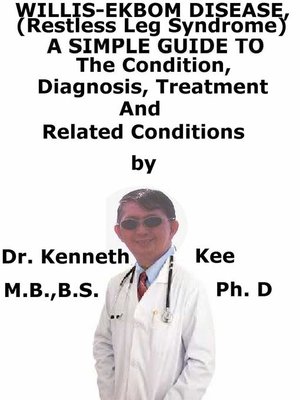Willis-Ekbom Disease (Restless Leg Syndrome), a Simple Guide to the Condition, Diagnosis, Treatment and Related Conditions
ebook
By Kenneth Kee

Sign up to save your library
With an OverDrive account, you can save your favorite libraries for at-a-glance information about availability. Find out more about OverDrive accounts.
Find this title in Libby, the library reading app by OverDrive.



Search for a digital library with this title
Title found at these libraries:
| Loading... |
This book describes Willis-Ekbom Disease or Restless Leg Syndrome, Diagnosis and Treatment and Related Diseases
Restless Legs Syndrome every one hates you.
You rob people of the sleep and make them blue
Out of the blue my legs started feeling funny
My RLS leaves me with very little energy
You make me have the urge to move my legs
I feel that ants are crawling on my skin and laying eggs
I only feel comfortable when my legs are kicking
These sensations becomes worse when I am sleeping
Even at rest the patient come and irritate me
When can I ever stop suffering and be free
Because of you I had to quit the job I loved
Every day I watched for triggers that make my RLS worse
Please help me, doctor, be kind
I think that I am going out of my mind
Please help me to stop my legs from fidgeting
And allow me at least some hours of good sleeping
-An original poem by Kenneth Kee
The other day I had one patient who could not sleep for a few nights before of jerking movements of his legs one leg after the other.
He felt that he just has to move his legs because of the funny sensations he felt in the legs.
They occur only when he was lying still trying to sleep.
Primary
I found out that he was taking a high dose of antihistamine for his cold symptoms and asked him to stop them.
I also gave him some clonazepam (a mild tranquillizer with anti convulsant effect) to be taken only if he still has the jerking movements.
Happily for him after stopping the antihistamine his jerking movements stopped and he did not have to take the clonazepam.
Willis-Ekbom disease or Restless Legs Syndrome is a neurological movement disorder featured by a distressing need or urge to move the legs or arms (akathisia) normally followed by an uncomfortable deep-seated sensation in the legs that is activated by:
1. Rest;
2. Sitting or lying down,
3. Worsening at night or in the evening.
It is relieved by moving or walking.
It most often affects the legs, but can affect the arms, body, head, and even phantom limbs.
People who have RLS depict the unpleasant feelings as creeping, crawling, pulling, itching, tingling, burning, aching or electric shocks.
There is sleep disturbance and a link with involuntary jerking movements of the legs during sleep called periodic leg movements of sleep.
There are 2 types of Restless Legs Syndrome:
A. Primary or idiopathic central nervous system (CNS) disorder can be familial with a pattern of autosomal dominant or recessive inheritance happening at an earlier age of onset of 45 years and slower disease progression.
Psychiatric factors, stress, and fatigue can make the symptoms of restless legs syndrome worse.
B. Secondary Restless Legs Syndrome can happen due to some linked disorders such as:
1. Iron deficiency (especially); blood ferritin below 50 μg/L (seen in 20% of cases)
2. Peripheral neuropathy
3. Hypoglycemia
4. Parkinson's Disease
5. Folate or magnesium deficiency
6. Vitamin B-12 deficiency
7. Diabetes mellitus
8. Frequent blood donation
9. Rheumatic disease and Rheumatoid arthritis
10. Uremia
11. End-stage renal disease (seen 25-50% of patients with End stage renal disease may improve after kidney transplant)
12. Pregnancy (seen in 25-40% of pregnant women normally subsides within a few weeks after delivery).
Restless legs syndrome is diagnosed on history taking and 4 diagnostic criteria:
1. An urge to move the legs, normally accompanied by unpleasant sensations;
2. Occurrence of symptoms during rest;






